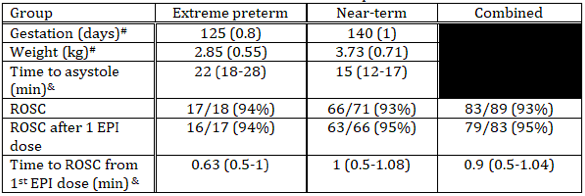Neonatal/Infant Resuscitation
Category: Abstract Submission
Neonatal/Infant Resuscitation I
476 - Optimal Interval Between Epinephrine Doses During Neonatal Resuscitation
Saturday, April 23, 2022
3:30 PM - 6:00 PM US MT
Poster Number: 476
Publication Number: 476.230
Publication Number: 476.230
Morgan Hardie, University of California, Davis, School of Medicine, Davis, CA, United States; Houssam M. Joudi, University of California, Torrance, CA, United States; Amy Lesneski, University of California, Davis, School of Medicine, Davis, CA, United States; Deepika Sankaran, University of California Davis Children's Hospital, Sacramento, CA, United States; Vishal Kapadia, University of Texas Southwestern Medical School, Dallas, TX, United States; Peggy Chen, Miller Children's & Women's Hospital Long Beach, Long Beach, CA, United States; Ziad Alhassen, Children's Hospital of Orange County, Orange, CA, United States; Satyan Lakshminrusimha, University of California Davis Children's Hospital, Sacramento, CA, United States; Payam Vali, University of California Davis Children's Hospital, Sacramento, CA, United States

Morgan Hardie, BSc (she/her/hers)
Staff Research Associate II
University of California, Davis
Davis, California, United States
Presenting Author(s)
Background:
In neonates who remain severely bradycardic or asystolic despite effective positive pressure ventilation (PPV), administration of intravenous (IV) epinephrine (EPI) has been shown to be effective in establishing return of spontaneous circulation (ROSC). A shorter time to the first dose of EPI has been shown to improve ROSC success. The current NRP guidelines recommend repeating EPI every 3-5 min if ROSC is not achieved. Time to achieve ROSC following IV EPI may potentially dictate optimal time interval between doses.
Objective:
To determine the time taken from EPI administration to achieve ROSC in a perinatal asphyxiated cardiac-arrested lamb model.
Design/Methods:
Extremely premature (~125d) and near-term (~140d gestation; term is ~145d) fetal lambs were partially exteriorized, instrumented and subsequently asphyxiated to cardiac arrest by umbilical cord compression. Following a 5-min period of asystole lambs were given PPV for 30s, and then received chest compressions (CC) if the heart rate was < 60 beats per min. IV EPI (0.01-0.03 mg/kg) was given at 1 to 5 min after initiation of CC. EPI was repeated q3min until ROSC or for a total of 4 doses.
Results:
Lamb characteristics are shown in Table 1. Eighty-nine lambs have been studied (71 near-term and 18 extremely preterm) with an ROSC success of 83/89 (93%; 66/71 and 17/18, respectively). Seventy-nine lambs achieved ROSC after one dose of EPI (79/83 = 95%) in a median time of 0.9 (IQR 0.5-1.04, range 0.5-2.2) min after the dose. For the 4 lambs that got ≥2 EPI doses, the median time to ROSC from the last dose was 1 (IQR 1-1.25, range 1-2) min.
Conclusion(s):
ROSC is typically achieved within 2 min following IV EPI in extremely preterm and near-term lambs with asphyxial cardiac arrest. Lambs are unlikely to achieve ROSC past 2 min from an effective IV dose of EPI. A shorter interval (such as 2 min) to repeat EPI may hasten ROSC.
Table 1: Lamb Characteristics and time to return of spontaneous circulation #Data are mean (SD). &Data are median (IQR). EPI = epinephrine; ROSC = return of spontaneous circulation
#Data are mean (SD). &Data are median (IQR). EPI = epinephrine; ROSC = return of spontaneous circulation
In neonates who remain severely bradycardic or asystolic despite effective positive pressure ventilation (PPV), administration of intravenous (IV) epinephrine (EPI) has been shown to be effective in establishing return of spontaneous circulation (ROSC). A shorter time to the first dose of EPI has been shown to improve ROSC success. The current NRP guidelines recommend repeating EPI every 3-5 min if ROSC is not achieved. Time to achieve ROSC following IV EPI may potentially dictate optimal time interval between doses.
Objective:
To determine the time taken from EPI administration to achieve ROSC in a perinatal asphyxiated cardiac-arrested lamb model.
Design/Methods:
Extremely premature (~125d) and near-term (~140d gestation; term is ~145d) fetal lambs were partially exteriorized, instrumented and subsequently asphyxiated to cardiac arrest by umbilical cord compression. Following a 5-min period of asystole lambs were given PPV for 30s, and then received chest compressions (CC) if the heart rate was < 60 beats per min. IV EPI (0.01-0.03 mg/kg) was given at 1 to 5 min after initiation of CC. EPI was repeated q3min until ROSC or for a total of 4 doses.
Results:
Lamb characteristics are shown in Table 1. Eighty-nine lambs have been studied (71 near-term and 18 extremely preterm) with an ROSC success of 83/89 (93%; 66/71 and 17/18, respectively). Seventy-nine lambs achieved ROSC after one dose of EPI (79/83 = 95%) in a median time of 0.9 (IQR 0.5-1.04, range 0.5-2.2) min after the dose. For the 4 lambs that got ≥2 EPI doses, the median time to ROSC from the last dose was 1 (IQR 1-1.25, range 1-2) min.
Conclusion(s):
ROSC is typically achieved within 2 min following IV EPI in extremely preterm and near-term lambs with asphyxial cardiac arrest. Lambs are unlikely to achieve ROSC past 2 min from an effective IV dose of EPI. A shorter interval (such as 2 min) to repeat EPI may hasten ROSC.
Table 1: Lamb Characteristics and time to return of spontaneous circulation
 #Data are mean (SD). &Data are median (IQR). EPI = epinephrine; ROSC = return of spontaneous circulation
#Data are mean (SD). &Data are median (IQR). EPI = epinephrine; ROSC = return of spontaneous circulation